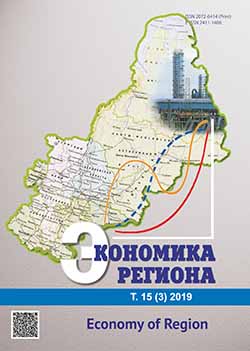ИССЛЕДОВАНИЕ МЕЖРЕГИОНАЛЬНЫХ ВЗАИМОСВЯЗЕЙ В ПРОЦЕССАХ ФОРМИРОВАНИЯ ИНВЕСТИЦИОННОГО ПОТЕНЦИАЛА ТЕРРИТОРИЙ МЕТОДАМИ ПРОСТРАНСТВЕННОГО МОДЕЛИРОВАНИЯ
Investigation of the Interregional Relationships in the Processes of Shaping the Territories’ Investment Potential Using the Methods of Spatial Modelling
Author(s): Ilya Viktorovich NaumovSubject(s): Economy
Published by: Институт экономики Уральского отделения Российской академии наук
Keywords: investment potential of the region; investment resources of the banking sector; gross regional product; interregional relations; spatial Moran’s autocorrelation; distance matrix
Summary/Abstract: In the context of an acute shortage of financial resources for improving the economy’s real sector and necessity to solve crucial socio-economic problems of the territorial systems’ development, the significance of the studies on the processes of reproducing the territories’ investment potential increases. Moreover, it is crucial to assess the priority directions for shaping the investment potential and the related inter-territorial relationships in order to examine the centres of the investment resources’ attraction, zones of their influence and unrelated territories with a low level of the potential’s development. The paper analyses the methods for studying the inter-territorial relationships and substantiates the necessity to use spatial autocorrelation and autoregression. I present a methodological approach to studying the interregional relationship. This approach allows identifying sources for shaping the investment potential of the regions’ economic growth. Furthermore, this approach suggests modelling the potential’s structure in the priority directions of economic activity using correlation and regression analysis. I study the interregional relationships in the processes of shaping the investment potential in the priority directions of economic activity applying the spatial autocorrelation method and using various types of distance matrices. Based on this approach, I identify priority directions for shaping the investment potential of the region’s economic growth (mining, manufacturing, construction, transport infrastructure and logistics, education). Moreover, examination of the specific character of the interregional relationships in the priority directions has allowed identifying four clusters of closely interrelated regional systems in the Russian Federation. They include «Central cluster» (Moscow, Moscow region, Tula region, Samara region), «North-West cluster» (St. Petersburg and Leningrad region), «Ural cluster» (Tyumen Region, Sverdlovsk Region, Chelyabinsk Region, Republic of Bashkortostan, Perm Krai, Khanty-Mansi Autonomous District, Yamalo-Nenets Autonomous District) and «South cluster» (Krasnodar Krai, Republic of Adygea, Republic of Crimea, Sevastopol). I have confirmed the established interregional relationships by analyzing the cluster structures operating on their territory in the priority directions of economic activity. The study’s results can be used by researchers for shaping spatial models of the regions’ economic development, as well as by public authorities for implementing the Spatial Development Strategy of the Russian Federation for the period up to 2025.
Journal: Экономика региона
- Issue Year: 15/2019
- Issue No: 3
- Page Range: 720-735
- Page Count: 15
- Language: Russian

